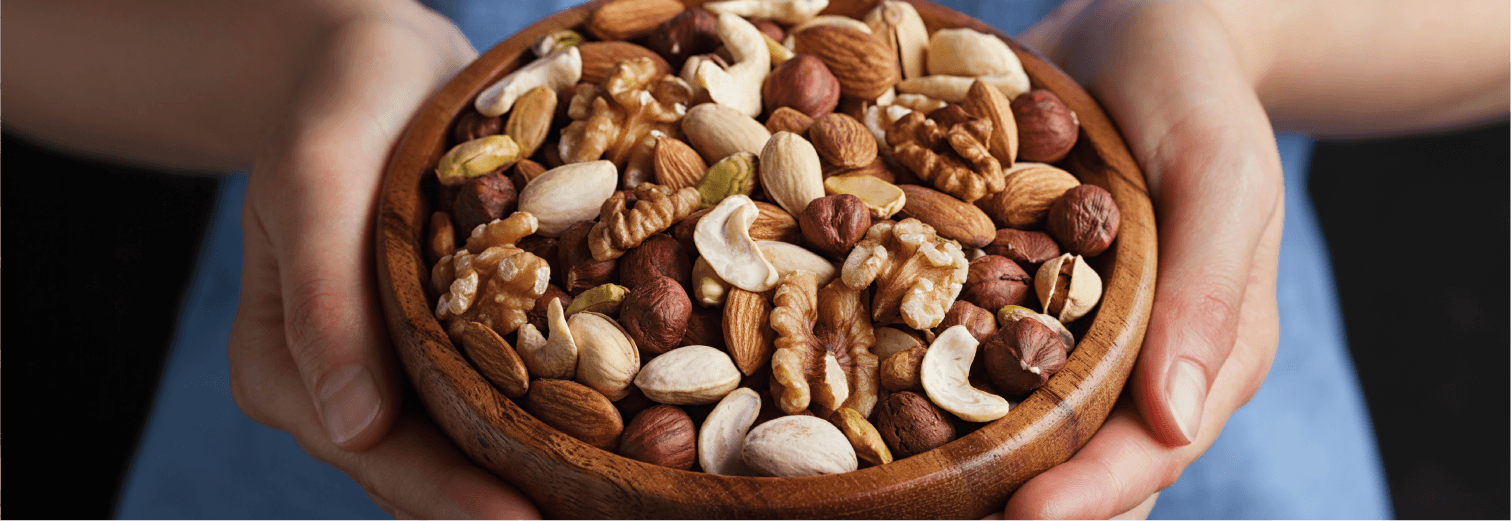Blog

Go Nuts Celebrating National Nutrition Month!
March is National Nutrition Month and there are few better foods to celebrate with than nuts! Adding a handful of tree nuts to your day can bring you a nutritional boost. Rich in unsaturated fats, all nuts also contain protein, fiber and important vitamins and minerals. In 2003, the U.S. Food and Drug Administration (FDA) announced one of the first qualified health claims: “Scientific evidence suggests but does not prove that eating 1.5 ounces per day of most nuts as part of a diet low in saturated fat and cholesterol may reduce the risk of heart disease.”
In recent years, more research has shown the potential benefits of tree nuts on other conditions such as diabetes and cancer, as well as satiety and maintenance of a healthy body weight. While all tree nuts provide important nutrients, they do each have their own special attributes.
Almonds and Vitamin E – Almonds are an excellent source of vitamin E, a powerful antioxidant, that enhances our immune system and is involved with heart health. Almonds are likely the most widely available nut in many forms – raw, roasted, sliced, slivered, milk, or as meal which is a great flour substitute in cakes and wonderful Macaroons.
Brazil Nuts and Selenium – Just one Brazil nut gives you all of the selenium you need per day. Selenium has antioxidant properties that help to break down peroxides, which can damage tissues and DNA, leading to inflammation and other health problems. Brazil nuts are fabulous in cakes and cookies, diced and scattered over salads or through pasta, like this Wild Mushroom Pasta Dish.
Cashews and Magnesium – Cashews are rich in the mineral magnesium, which has many roles in the body such as building proteins and strong bones, and regulating blood sugar, blood pressure and muscle and nerve functions. Take a feather out of the Asian cook’s cap and toss luscious and slightly sweet cashews in your next stir fry. Top our tasty Cashew and Noodle Sang Choy Bow with a scattering of roasted cashews, or just munch a few on your next hike.
Hazelnuts and Vitamin E – Like almonds, hazelnuts are a rich source of Vitamin E as well as fiber, protein and healthy fats. The Mediterranean diet incorporates hazelnuts in many ways, from a rich and flavorful oil, to use as a base for desserts and pastries. Try a dressing with hazelnut oil and lemon, over a Tricolor Salad, with chopped hazelnuts and goat cheese and you’ll be transported to Italy. Hazelnut pesto is wonderful in pasta and for drizzling over chicken and fish.
Macadamias and Manganese – This native Australian nut was once used by the Aboriginal community to provide lasting sustenance for long walkabouts from the coast inland, and can do the same for us on long periods of activity. They are a great source of manganese, which is involved in skeletal health among other benefits. In this shortbread recipe, ground macadamias replace all of the butter, and you’d never know it!
Pecans and Flavonoids – Pecans are rich in flavonoids, plant chemicals that have antioxidant and anti-inflammatory properties that are associated with a reduced risk of a number of chronic diseases, including cancer and heart disease. This dark and deliciously flavored nut, often seasoned with spices or honey, adds a wonderful dimension to salads, and can provide a creative twist to your favorite Mac and Cheese.
Pine Nuts and Copper – Like oysters, these little buttery gems are a great source of copper, a mineral the body uses to form red blood cells, bone, connective tissue and some important enzymes. Known mostly in the US as a base for pesto or scattered on salads, the Europeans use pine nuts extensively as an ingredient in breads, candies, cookies, cakes, sauces, fish, vegetable dishes and meat dishes such as these Lamb and Pine Nut Pastries.
Pistachios and Plant Sterols – On top of being a good source of healthy fats and potassium, pistachios are known for their contribution of plant sterols to the diet. Plant sterols have been linked to lowering cholesterol, particularly LDL (the bad guy). Pistachio’s rich green flavor makes them a delightful addition to cookies, sauces, smoothies or as a lovely contrast on this potato soup.
Walnuts and Omega 3’s – Walnuts are high in polyunsaturated fats and are one of a few significant plant sources of heart-friendly omega-3 fatty acids. This versatile tree nut can cross all borders when it comes to meals and cultures. Walnuts are great for breakfast with yogurt and granola, in a rich moist banana or zucchini bread, over grain salads, or in this classic creamy sauce for pasta.
Bottom line? All tree nuts fit into a healthy diet. Celebrate National Nutrition Month by simply choosing your favorites and enjoying a nutritious mixture—Bon Appetit!
previous post
Go Nuts for a Healthy Weight!next post
Nuts About Mother’s Day